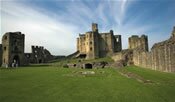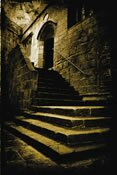Inflight Magazine of Brussels Airlines
Welcome to the Inflight Magazine of Brussels Airlines
The haunted coast
Text David Sandhu
Image Getty images
Inspired by all manner of ghostly goings-on, the rugged terrain of Northumberland is home to some extraordinary myths and legends
 As the setting for Hogwarts in the early Harry Potter films. Alnwick Castle has helped put Northumberland in the spotlight over recent years, but beyond Harry Potter, there is more than enough supernatural magic here just waiting to be discovered. Autumn is perhaps the best times to tour this wild coastline. The summer tourists have dispersed and the long, largely deserted stretches of sand offer long walks in the salty air.
As the setting for Hogwarts in the early Harry Potter films. Alnwick Castle has helped put Northumberland in the spotlight over recent years, but beyond Harry Potter, there is more than enough supernatural magic here just waiting to be discovered. Autumn is perhaps the best times to tour this wild coastline. The summer tourists have dispersed and the long, largely deserted stretches of sand offer long walks in the salty air.
Despite Alnwick’s film-star glamour, it doesn’t quite match the mystique of Dunstanburgh near Craster. These brooding ruins, clinging to the coastal headland overlooking Embleton Bay, can only be reached on foot. Not surprisingly, following the War of the Roses, this lonely site was considered too remote to be a military asset and fell into decay. Midnight is the time to make a perilous pilgrimage in search of haunted happenings, chiefly those of Sir Guy, The Seeker…
The story goes that Sir Guy was sheltering from a storm near Dunstanburgh Castle when he was accosted by a wizard (Merlin, no less) who told him of an enchanted maiden in distress. In the Great Hall, Sir Guy was asked to choose between a sword and a horn to help his quest (one to fight, the other to summon help). Tragically, he chose the horn and, upon a mighty blow, 100 white knights on black horses charged at him.
He immediately found himself outside the castle, destined never again to find his true love.
 After his death, Sir Guy apparently became a ghost vainly seeking the lady, his cries ringing through the chilly ruins at midnight. And what of the maiden? The White Lady is described as a preRaphaelite watercolour, with pale-pink cheeks and raven-black hair, who stills waits for her knight.
After his death, Sir Guy apparently became a ghost vainly seeking the lady, his cries ringing through the chilly ruins at midnight. And what of the maiden? The White Lady is described as a preRaphaelite watercolour, with pale-pink cheeks and raven-black hair, who stills waits for her knight.
Another dramatic ruin is Warkworth Castle, on a charming wooded bend of the River Coquet. Although in slightly better repair than Dunstanburgh, only its perimeter originates from the original 12th-century site. Shakespeare used the castle for the setting of the opening scene of Henry IV (Part II), referring to ‘this worm-eaten hold of rugged stone, where Hotspur’s
father, old Northumberland, lies crafty, sick.’ Don’t miss the rowboat trip to Warkworth’s tiny stone hermitage where a story of Shakespearean tragic proportions was concluded…
Sir Bertram fell in love with Isabel, who sent him into battle to prove his devotion. On hearing he had suffered a serious wound, Isabel went in search of him but became lost. Eventually, Sir Bertram found her – alongside a male companion.
 After a fierce fight, Isabel and her companion were both killed by Sir Bertram, who subsequently discovered that the man was Isabel’s brother. Paralysed by remorse, he gave away all his properties and built a hermitage, carving a tiny cell, chapel and dormitory from the bare rock and living in solitude until his death 50 years later.
After a fierce fight, Isabel and her companion were both killed by Sir Bertram, who subsequently discovered that the man was Isabel’s brother. Paralysed by remorse, he gave away all his properties and built a hermitage, carving a tiny cell, chapel and dormitory from the bare rock and living in solitude until his death 50 years later.
At Bamburgh, romantic stories associate its imposing castle with King Arthur, suggesting that it was the site of the ‘castle of the Joyous Garde’ given to Sir Galahad. On a more freaky note, Bamburgh was also the backdrop for the tale of the ‘hand that did not perish’…
One Easter, King Oswald of Northumbria sat in the castle’s banqueting hall awaiting a feast when a group of starving beggars arrived. The King lifted a large silver dish heaped high with venison and wild boar and presented it to the hungry men. Bishop Aidan, impressed by this generosity, prayed that the arm that performed this deed might never decay. When Oswald later met his death in battle, the arm was placed in a magnificent shrine and remained intact for 900 years!
Just a few miles inland of Bamburgh lies the mysterious Spindlestone Heugh, where the lair of the Laidley Worm is believed to lurk…
 After years of mourning, the widowed king of Bernicia remarried a beautiful woman who, unbeknown to everyone, was a witch. The new Queen soon became jealous of Princess Margaret, the King’s beautiful daughter, and uttered a dreadful curse turning her into a ‘Laidley Worm’ (a loathsome serpent) that lived among the crags of Spindlestone. At night, the creature came out and spread terror and famine.
After years of mourning, the widowed king of Bernicia remarried a beautiful woman who, unbeknown to everyone, was a witch. The new Queen soon became jealous of Princess Margaret, the King’s beautiful daughter, and uttered a dreadful curse turning her into a ‘Laidley Worm’ (a loathsome serpent) that lived among the crags of Spindlestone. At night, the creature came out and spread terror and famine.
The spell could only be broken if the princess’s brother returned from ‘over the sea’ (the Crusades) and kissed her. Hearing of his sister’s plight, he made a perilous return and soon faced the fearsome Worm. He was about to strike it when the princess rediscovered her voice, begging him to “quit his sword and give her kisses three”. The spell broken, the prince and princess returned to Bamburgh Castle in triumph and the evil queen was transformed into an ugly toad. It’s said she still lives under the castle.
In fact, Northumberland contains more castles than any other part of the UK. But blessed by a wave of Harry Potter’s wand, it’s still Alnwick Castle that entrances most visitors. The £7m project to restore Alnwick Garden to its former glory offers another compelling reason to visit.
Yves de Vescy erected the earliest part of Alnwick Castle in 1096. and by the mid-14th century it already had today’s ghosts include the Radiant Boy, said to come from the fireplace in the Pink Bedroom, often in a blue flash which people mistake for an electrical fault. Years ago the bones of a young boy were discovered there. Meanwhile, the Grey Lady is said to be the ghost of the wife of Lord Grey. He ran away with her sister, and her ghost is believed to walk the corridors looking for him.
Finally, no tour of Northumberland is complete without taking the causeway to Lindisfarne, the Holy Island, home to the Lindisfarne Gospels, probably the finest illuminated English manuscripts of the Middle Ages . An intangible vibe remains on this isolated island. Stay overnight on Lindisfarne during a full moon and you may glimpse the ghost of Saint Cuthbert or the mysterious ‘white dog’ ghost gambolling through the frosty Priory ruins. Barking? Quite possibly.
Hadrian’s heritage
 With the success of the blockbuster exhibition Hadrian: Empire and Conflict, at the British Museum in London (until Oct 26, britishmuseum.org), more visitors than ever will be flocking to Hadrian’s Wall. One of Northumberland’s true icons and England’s largest UNESCO World Heritage Site, the wall was built by Roman Emperor Hadrian almost 2,000 years ago to separate the Romans from the ‘barbarians’. The landscape remains little changed since Roman eyes scoured the horizon for signs of northern invaders. Head for Chesters, home to the best preserved Roman cavalry fort in Britain, while Housesteads and Vindolanda are the sites of extensive remains of forts and civilian settlements. They contain unique artefacts including the Vindolanda Tablets – ancient letters written by Roman soldiers in the first century.
With the success of the blockbuster exhibition Hadrian: Empire and Conflict, at the British Museum in London (until Oct 26, britishmuseum.org), more visitors than ever will be flocking to Hadrian’s Wall. One of Northumberland’s true icons and England’s largest UNESCO World Heritage Site, the wall was built by Roman Emperor Hadrian almost 2,000 years ago to separate the Romans from the ‘barbarians’. The landscape remains little changed since Roman eyes scoured the horizon for signs of northern invaders. Head for Chesters, home to the best preserved Roman cavalry fort in Britain, while Housesteads and Vindolanda are the sites of extensive remains of forts and civilian settlements. They contain unique artefacts including the Vindolanda Tablets – ancient letters written by Roman soldiers in the first century.
FR Esprits et serpents
Entouré de toutes parts par des présences fantomatiques, le territoire tourmenté du Northumberland a produit des mythes et des légendes extraordinaires.
Le Northumberland contient plus de châteaux que n’importe quelle autre partie de l’Angleterre. Prenez le Château d’Alnwick, où ont été tournées des scènes de Harry Potter. Bien que le film lui ait apporté un côté glamour, il ne possède sans doute pas autant de puissance mystique que le Château de Dunstanburgh. Ces ruines lugubres, qui surplombent la Baie d’Embleton, sont seulement accessibles à pied et l’on dit qu’à minuit, les murailles résonnent des cris de Sir Guy, à la recherche de son amour perdu.
Le Château de Warkworth offre des ruines tout aussi grandioses, sur un bras boisé de la Rivière Coquet. Shakespeare a choisi ce lieu pour la scène d’ouverture d’Henry IV (IIème Partie). Ne manquez pas le déplacement en bateau à rames jusqu’au petit ermitage en vieilles pierres de Warkworth.
À Bamburgh, les histoires associent son château imposant au Roi Arthur, en suggérant qu’il pourrait être le site du château octroyé à Sir Galahad. À quelques kilomètres de là, dans l’intérieur des terres, trône le mystérieux Spindlestone Heugh, nommé d’après la légende comme le repaire de Laidley Worm (serpent répugnant).
C’est encore le Château d’Alnwick qui recense le plus grand nombre d’entrées. Fondé en 1096 par Yves de Vescy, il est resté la demeure familiale des Ducs de Northumberland durant près de 700 ans. Le projet de restauration des Jardins d’Alnwick, à hauteur de £7m, constitue une autre raison de le visiter.
Le Château de Chillingham a la réputation d’être le plus hanté de Grande-Bretagne. Parmi les fantômes les plus célèbres, on recense Radiant Boy, que l’on dit venu du feu ouvert dans la Chambre Rose et Grey Lady, dont le mari Grey est parti avec sa soeur.
Et pour terminer, une visite de Northumberland ne serait pas complète sans prendre la chaussée vers Lindisfarne, l’île Sacrée. Les Évangiles de Lindisfarne, manuscrits anglais enluminés du Moyen-âge, ont été réalisés dans le monastère fondé à cet endroit en 635 par Saint Aidan. Il reste une vibration intangible dans ce lieu isolé.
NL Spoken en serpenten
Het woeste Northumberland met zijn spookachtige verleden vormde een bron van inspiratie voor enkele buitengewone mythes en legendes.
Northumbria telt meer kastelen dan eender welk deel van het VK. Hoewel Alnwick Castle, waar stukken uit de films van Harry Potter werden gefilmd, voor de nodige Hollywoodglamour zorgde, kan het niet op tegen de bijzondere aantrekkingskracht van Dunstanburgh Castle. Deze dreigende ruïnes die uitkijken over Embleton Bay kun je enkel te voet bereiken. Volgens geruchten zouden de muren ’s nachts de kreten van Sir Guy weergalmen, op zoek naar zijn verloren liefde.
Een andere theatrale ruïne is Warkworth Castle, aan een bosrijke bocht van de rivier Coquet. Shakespeare koos het uit voor de openingsscène van zijn Hendrik IV (deel II). Mis de roeiboot naar de kleine, stenen hermitage van Warkworth niet!
In Bamburgh brengen verhalen het indrukwekkende kasteel in verband met Koning Arthur. Zo zou dit het kasteel van Sir Galahad zijn geweest. Enkele mijlen landinwaarts ligt het mysterieuze Spindlestone Heugh, dat volgens legendes de schuilplaats van de Laidley Worm (weerzinwekkend serpent) is.
Maar het is Alnwick Castle dat de meeste bezoekers in vervoering brengt. Het door Yves de Vescy in 1096 gebouwde kasteel bood bijna 700 jaar lang onderdak aan de Hertogen van Northumberland. Het project van 7 miljoen pond om Alnwick Garden op te knappen, is nog een mooie reden om het te bezoeken.
Chillingham Castle staat bekend als het grootste spookkasteel van Groot-Brittannië. Enkele van de geesten die er zouden verblijven, zijn de Radiant Boy, die uit de open haard in de Roze Slaapkamer komt, en de Grey Lady, wiens echtgenoot Lord Grey wegliep met haar zus.
Maar een rondrit in Northumberland is niet compleet zonder een tocht over de verhoogde weg naar Lindisfarne, het Heilige Eiland. De Gospels van Lindisfarne, verluchte Engelse manuscripten uit de Middeleeuwen, werden gemaakt in het klooster dat de heilige Aidan hier in 635 oprichtte. Bezoekers worden hier nog steeds bekropen door een ongrijpbaar gevoel.
Leave a Reply
